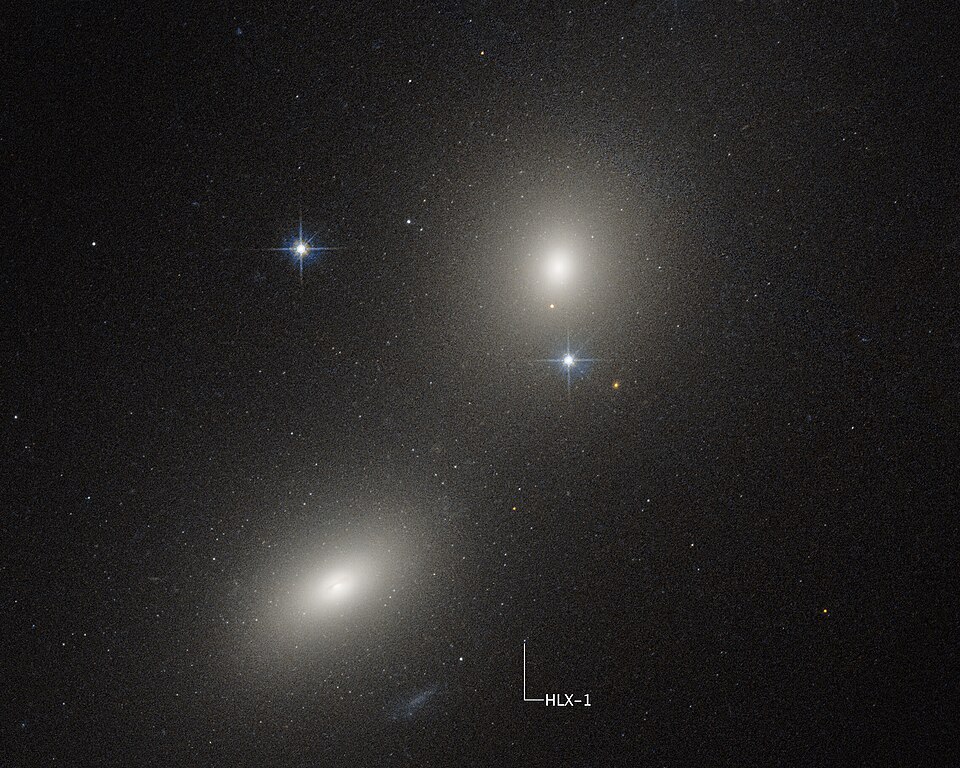NASA's Hubble and Chandra Identify Intermediate-Mass Black Hole

NASA's Hubble Space Telescope and Chandra X-ray Observatory have collaborated to identify a rare type of black hole, known as an intermediate-mass black hole (IMBH), located in the outskirts of galaxy NGC 6099. This discovery, detailed in the Astrophysical Journal, marks a significant advancement in understanding the range of black holes that exist in the universe, particularly in the elusive category of IMBHs, which weigh between a few hundred to 100,000 times the mass of our Sun.
The black hole, designated NGC 6099 HLX-1, resides approximately 450 million light-years away in the constellation Hercules. It was first detected as an unusual X-ray source in 2009 by Chandra and has since been monitored by the European Space Agency's XMM-Newton observatory. The IMBH is situated about 40,000 light-years from the center of its host galaxy, indicating that it is a free-floating entity rather than a central supermassive black hole, which are typically found at the cores of galaxies.
Intermediate-mass black holes are particularly intriguing because they represent a missing link in the evolutionary chain of black holes, situated between stellar-mass black holes, formed from the collapse of massive stars, and supermassive black holes, which can weigh billions of solar masses. According to Dr. Yi-Chi Chang, lead author of the study and an astrophysicist at National Tsing Hua University in Hsinchu, Taiwan, these black holes provide critical insights into the formation and growth of larger black holes over cosmic time. "X-ray sources with such extreme luminosity are rare outside galaxy nuclei and can serve as a key probe for identifying elusive IMBHs," Chang stated.
The X-ray emissions from NGC 6099 HLX-1, with a temperature of approximately three million degrees, are consistent with a tidal disruption event (TDE), which occurs when a black hole captures and shreds a star. This process generates an intense burst of radiation, allowing astronomers to detect the black hole's activity. Notably, the IMBH reached its peak brightness in 2012 before starting to decline, suggesting it may have recently consumed a star.
Dr. Roberto Soria, co-author of the study from the Italian National Institute for Astrophysics, emphasized the importance of continued observation. "We need to determine whether the IMBH will continue flaring or whether it has reached a new quiescent state after consuming a star. The variability in brightness provides essential clues about its feeding patterns and the surrounding environment," Soria explained.
The study of IMBHs is crucial not only for understanding black hole formation but also for unraveling the broader mysteries of galaxy evolution. There are two prevailing theories about how these black holes form. One theory suggests that IMBHs could be the seeds for supermassive black holes, coalescing over time through mergers with other black holes and gas clouds. The other theory posits that they may form directly from the collapse of gas clouds in the early universe, bypassing the stellar phase entirely.
NASA's James Webb Space Telescope has also contributed to the understanding of black holes, revealing that some distant black holes are disproportionately more massive than their host galaxies. This observation raises questions about the growth mechanisms of black holes and suggests there may be a wider variety of black hole types than currently recognized.
Looking forward, the Vera C. Rubin Observatory in Chile, set to begin full operations in the near future, is expected to play a pivotal role in the search for new IMBHs. Its all-sky survey capabilities will allow for the detection of tidal disruption events from black holes consuming stars, potentially increasing the catalog of known IMBHs and refining our understanding of black hole population dynamics.
The Hubble Space Telescope has been instrumental in numerous groundbreaking discoveries since its launch in 1990, and its ongoing mission continues to enhance our knowledge of the universe. This latest discovery underscores the importance of multi-telescope collaborations in advancing astrophysics and deepening our comprehension of cosmic phenomena. For further information and access to high-resolution images, visit the Space Telescope Science Institute's website.
Advertisement
Tags
Advertisement





